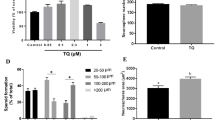Abstract
It was shown previously that a single episode of pentylenetetrazole-induced generalized seizures was accompanied by learning and memory impairments in rodents. The temporal profile of these impairments suggests that their development at least partially was determined by changes in adult neurogenesis. On the other hand, the cannabinoid receptor agonist tetrahydrocannabinol is known for its protective effect versus seizure-induced cognitive impairments. The aim of our present study was to determine whether tetrahydrocannabinol affects the process of adult neurogenesis in the hippocampus, and whether there is a link between tetrahydrocannabinol-induced changes in adult neurogenesis and memory function in rats. We discovered that tetrahydrocannabinol applied at an ultra-low dose (2 µg/kg) at early stages of differentiation contributes to better survival of newly-born cells in the hippocampus. We also established a significant correlation between the number of newly-born cells that survived in the hippocampus after 3 months and the long-term memory in rats. This finding may indicate that the protective effect of tetrahydrocannabinol on young hippocampal cells may participate in its cognitive effect.
Similar content being viewed by others
References
Abrous, D.N. Koehl, M., and Le Moal M., Physiol. Rev., 2005, vol. 85, no. 2, pp. 523–569.
Jakubs, K., Nanobashvili, A., Bonde, S., Ekdahl, C.T., Kokaia, Z., Kokaia, M., and Lindvall, O., Neuron, 2006, vol. 52, no. 6, pp. 1047–1059.
Scharfman, H.E., Neuroscientist, 2002, vol. 8, no. 2, pp. 154–173.
Assaf, F., Fishbein, M., Gafni, M., Keren, O., and Sarne, Y., Behav. Brain Res., 2011, vol. 220, no. 1, pp. 194–201.
Aniol, V.A., Ivanova-Dyatlova, A.Y., Keren, O., Guekht, A.B., Sarne, Y., and Gulyaeva, N.V., Epilepsy & Behavior, 2013, vol. 26, no. 2, pp. 196–202.
Jiang, W., Wan, Q., Zhang, Z.J., Wang, W.D., Huang, Y.G., Rao, Z.R., and Zhang, X., Brain Res., 2003, vol. 977, no. 2, pp. 141–148.
Franke, H. and Kittner, H., Pharmacol. Biochem. Behav., 2001, vol. 70, nos. 2–3, pp. 291–303.
Aniol, V.A., Stepanichev, M.Y., Lazareva, N.A., and Gulyaeva, N.V., Epilepsy & Behavior, 2011, vol. 22, no. 3, pp. 433–441.
Cilio, M.R., Thiele, E.A., and Devinsky, O., Epilepsia, 2014, vol. 55, no. 6, pp. 787–790.
Irving, A.J., Rae, M.G., and Coutts, A.A., Scientific World Journal, 2002, vol. 2, pp. 632–648.
Trazzi, S., Steger, M., Mitrugno, V.M., Bartesaghi, R., and Ciani, E., J. Biol. Chem., 2010, vol. 285, no. 13, pp. 10098–10109.
Kochman, L.J., Santos, A.A., Fornal, C.A., and Jacobs, B.L., Brain Res., 2006, vol. 1113, no. 1, pp. 86–93.
Compagnucci, C., Di Siena, S., Bustamante, M.B., Di Giacomo, D., Di Tommaso, M., Maccarrone, M., Grimaldi, P., and Sette, C., PLoS One, 2013, vol. 8, no. 1.
Fishbein-Kaminietsky, M., Gafni, M., and Sarne, Y., J. Neurosci. Res., 2014, vol. 92, no. 12, pp. 1669–1677.
Saxe, M.D., Malleret, G., Vronskaya, S., Mendez, I., Garcia, A.D., Sofroniew, M.V., Kandel, E.R., and Hen, R., Proc. Natl. Acad. Sci. USA, 2007, vol. 104, no. 11, pp. 4642–4646.
Jessberger, S., Clark, R.E., Broadbent, N.J., Clemenson, G.D., ffixJr., Consiglio, A., Lie, D.C., Squire, L.R., and Gage, F.H., Learn. Mem., 2009, vol. 16, no. 2, pp. 147–154.
Author information
Authors and Affiliations
Corresponding author
Additional information
Original Russian Text © A.Yu. Ivanova-Dyatlova, V.A. Aniol, N.V. Gulyaeva, 2015, published in Neirokhimiya, 2015, Vol. 32, No. 3, pp. 265–270.
Rights and permissions
About this article
Cite this article
Ivanova-Dyatlova, A.Y., Aniol, V.A. & Gulyaeva, N.V. Ultra-low doses of tetrahydrocannabinol contribute to the survival of newly-born cells in the dentate gyrus of adult rats. Neurochem. J. 9, 232–236 (2015). https://doi.org/10.1134/S1819712415030046
Received:
Published:
Issue Date:
DOI: https://doi.org/10.1134/S1819712415030046




